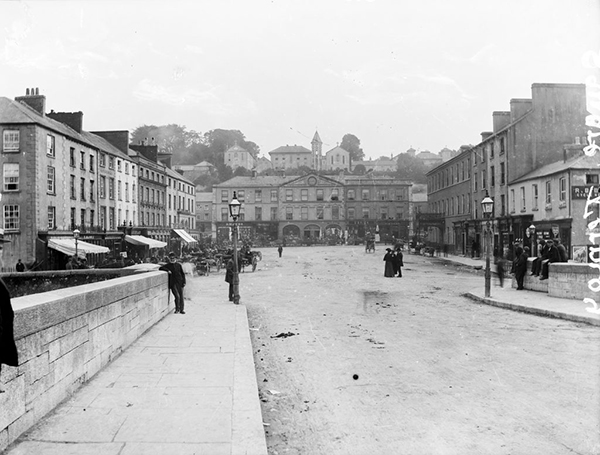100 YEARS AGO: First War of Independence raid on British soldiers (and first reprisal), Fermoy, September 1919
Published in Issue 5 (September/October 2019), Volume 27By Joseph E.A. Connell Jr

Above: Queen Square (now Pearse Square), Fermoy, Co. Cork, in the early twentieth century. (NLI)
The first organised action against British military forces after the Rising took place at Fermoy on Sunday 7 September 1919. The IRA’s Cork No. 2 Brigade carried it out under the command of Liam Lynch. Their objective was an armed party of British soldiers who attended Sunday service at the Wesleyan church at the eastern end of the town, about half a mile from their barracks. The soldiers always carried their rifles to church. The IRA didn’t know whether they were loaded or not, but it was assumed that they were and plans were made for that contingency.
About 10.30am, fourteen soldiers and a corporal left their barracks and marched through the town towards the church. They carried their rifles on their shoulders, completely at their ease.
Approximately 25 Volunteers from Fermoy company, armed with just six revolvers between them, assembled in groups of two or three in the vicinity of the church. They remained well spread out to avoid attracting attention. Another group was detailed to collect the British rifles after the ambush and transfer them to cars parked nearby—capture of the weapons was the goal of the operation. Any Volunteers who were unarmed carried short clubs in case there was a hand-to-hand fight.
One of the IRA’s cars, with George Power in charge, was halted near the church, with two men attending to an imaginary breakdown. The second car, with Liam Lynch inside, drove up Patrick Street behind the party of soldiers, timing it to arrive at the church at the same moment as the soldiers. This coordination of attack was new to the IRA and was essential to the success of the plan, but they were able to carry it off in a timely manner.
A whistle blast began the assault. Liam Lynch called on the soldiers to surrender but they immediately resisted. The attackers rushed them, shots were fired and for a minute or two there was a confused struggle. A soldier swinging a rifle butt at Lynch was shot dead while three others were wounded. When the soldiers were finally overpowered, their rifles were taken from them and piled into the waiting car. It turned out that the British rifles were not loaded and they resisted by using their rifles as clubs.
Much thought had been given to the selection of men for the ambush. It was inevitable that those who were well known locally would have to go on the run. Intensive searches by military and police continued throughout the day. Parties of military in lorries scoured the countryside, cars were held up and many people questioned. Two days later the district was proclaimed a military area.
On the Monday night following the raid, soldiers from the British garrison at Fermoy descended upon the town, smashing windows and looting the contents of shops. Just as this was the first attack on British soldiers after the Rising, this was also the first reprisal of the War of Independence. By the standards of later reprisals the damage was minimal, but the pattern of ‘reprisal following raid’ was established.
Joseph E.A. Connell Jr is the author of Michael Collins: Dublin 1916–22 (Wordwell Books).
















